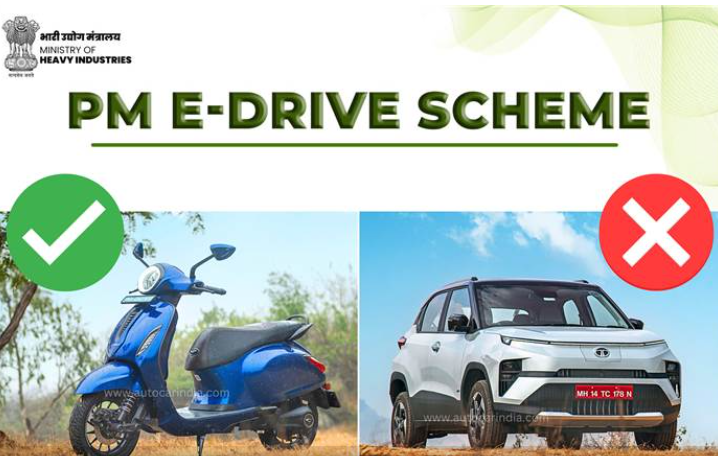PM E-DRIVE Scheme (GS Paper 2, Government Policies)

Introduction
- The Indian government has launched the PM E-DRIVE Scheme, aimed at accelerating the adoption of electric vehicles (EVs) in the country.
- This initiative focuses on establishing a robust charging infrastructure and enhancing the EV manufacturing ecosystem, thereby addressing environmental concerns and promoting sustainable transportation solutions.
Overview of the PM E-DRIVE Scheme
- Implementation Period: The scheme is set to run from October 1, 2024, to March 31, 2026.
- Integration with Existing Policies: The new scheme subsumes the Electric Mobility Promotion Scheme (EMPS-2024), consolidating efforts to promote electric mobility.
Key Features of the PM E-DRIVE Scheme
Subsidy Structure:
- Electric Two-Wheelers: A subsidy of ₹5,000 per kilowatt-hour (kWh) will be provided, with an overall cap of ₹10,000 in the first year. In the second year, the subsidy will be reduced to ₹2,500 per kWh, with a total cap of ₹5,000.
- Three-Wheelers: E-rickshaws will receive a demand incentive of ₹25,000 in the first year, halving to ₹12,500 in the second year.
- Cargo Three-Wheelers (L5 Category): A benefit of ₹50,000 will be available in the first year, which will drop to ₹25,000 in the second year.
e-Vouchers:
- The Ministry of Heavy Industries will introduce e-vouchers for EV buyers to claim their incentives.
- Only one vehicle can be registered per Aadhaar number. An e-voucher will be generated once a vehicle is sold, which manufacturers must use to claim reimbursement.
Charging Infrastructure:
- To combat range anxiety among potential EV buyers, the scheme promotes the establishment of public electric vehicle charging stations (EVPCS) in urban centers with high EV adoption rates and along selected highways.
Understanding Electric Vehicles (EVs)
Electric vehicles operate using an electric motor, as opposed to traditional internal combustion engines that rely on fossil fuels. This shift offers a potential solution to rising pollution, global warming, and the depletion of natural resources.
Benefits of Electric Vehicles:
- Energy Efficiency: Electric motors convert a higher percentage of energy from the grid into vehicle movement compared to conventional engines.
- Lower Operating Costs: EVs typically have lower running costs than their petrol or diesel counterparts.
- Environmental Impact: With zero tailpipe emissions, EVs help mitigate air pollution and reduce greenhouse gas emissions.
- Reduced Dependence on Fossil Fuels: EVs promote energy independence, reducing vulnerability to fluctuating fuel prices.
- Health Benefits: By improving air quality, EVs can lower the incidence of respiratory illnesses and other health issues linked to pollution.
India’s Electric Vehicle Policy Framework
To facilitate the growth of the EV sector, the Indian government has laid out a comprehensive policy framework:
- National Electric Mobility Mission Plan (NEMMP): Launched in 2013, the NEMMP aims to achieve fuel security through the promotion of hybrid and electric vehicles.
- FAME India Scheme: The Faster Adoption and Manufacturing of Electric Vehicles (FAME) India scheme, initiated in 2015, aims to bolster the manufacturing and adoption of EVs through incentives and subsidies.
- Goods and Services Tax (GST) Reduction: The GST on electric vehicles has been reduced from 12% to 5%, making EVs more affordable.
- Charging Infrastructure Expansion: The government is focused on expanding the network of charging stations across the country to alleviate range anxiety.
- Incentives for Manufacturers: Alongside consumer incentives, the government is providing subsidies to manufacturers to promote domestic EV production.
- Battery Swapping Policy: To address concerns regarding charging infrastructure, the government is exploring battery swapping stations for quick battery exchanges.
- Production-Linked Incentive (PLI) Scheme: Launched in 2021, this scheme aims to boost domestic manufacturing capabilities for advanced chemistry cell (ACC) batteries, crucial for EV production.
Challenges in Electric Vehicle Adoption
Despite the government's efforts, several challenges hinder the widespread adoption of EVs in India:
- High Initial Cost: The upfront price of electric vehicles remains relatively high compared to traditional vehicles, deterring potential buyers.
- Limited Charging Infrastructure: A significant barrier to EV adoption is the insufficient availability of charging stations across the country.
- Range Anxiety: The fear of running out of battery before reaching a charging station remains a prevalent concern among consumers.
- Battery Technology and Supply Chain Issues: India relies heavily on imported lithium-ion batteries, increasing costs and making the EV sector vulnerable to supply chain disruptions.
- Consumer Awareness: A lack of awareness about the benefits and technologies associated with electric vehicles can hinder adoption.
- Socioeconomic Factors: Economic disparities and varying levels of consumer preference across different regions influence EV adoption rates.
Way Forward
To effectively overcome the challenges and promote EV adoption, India must focus on several key strategies:
- Securing Lithium Resources: Actively seeking lithium resources is essential for supporting domestic battery production and meeting EV demand. This includes exploring lithium deposits in regions like Jammu and Kashmir.
- State-Level Initiatives: States like Telangana are positioning themselves as EV manufacturing hubs, creating an ecosystem that supports local production and innovation.
- Enhancing Consumer Education: Conducting awareness campaigns to inform consumers about the benefits and availability of electric vehicles can drive adoption.
- Investment in Infrastructure: Continued investment in charging infrastructure is critical to alleviate range anxiety and encourage consumer confidence in EVs.
- Collaborating with Industry Stakeholders: Partnering with private sector players, NGOs, and educational institutions can help facilitate knowledge sharing, innovation, and investment in the EV ecosystem.
Conclusion
- The PM E-DRIVE Scheme is a significant step towards accelerating the adoption of electric vehicles in India.
- By addressing the barriers to EV adoption and promoting a sustainable transportation ecosystem, the government aims to reduce environmental impact, enhance energy security, and position India as a leader in the global electric vehicle market.
- The success of this initiative will depend on collaborative efforts from various stakeholders, including government agencies, industry players, and consumers.


